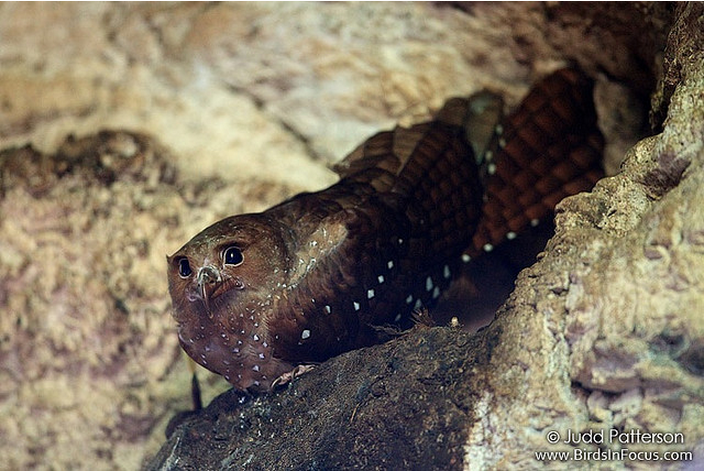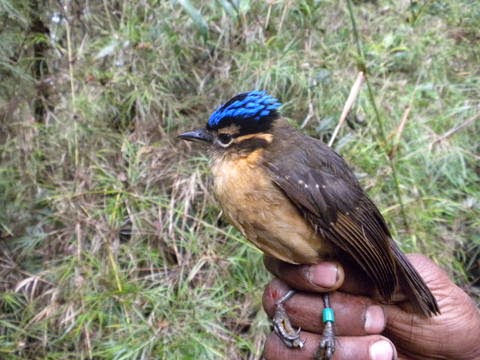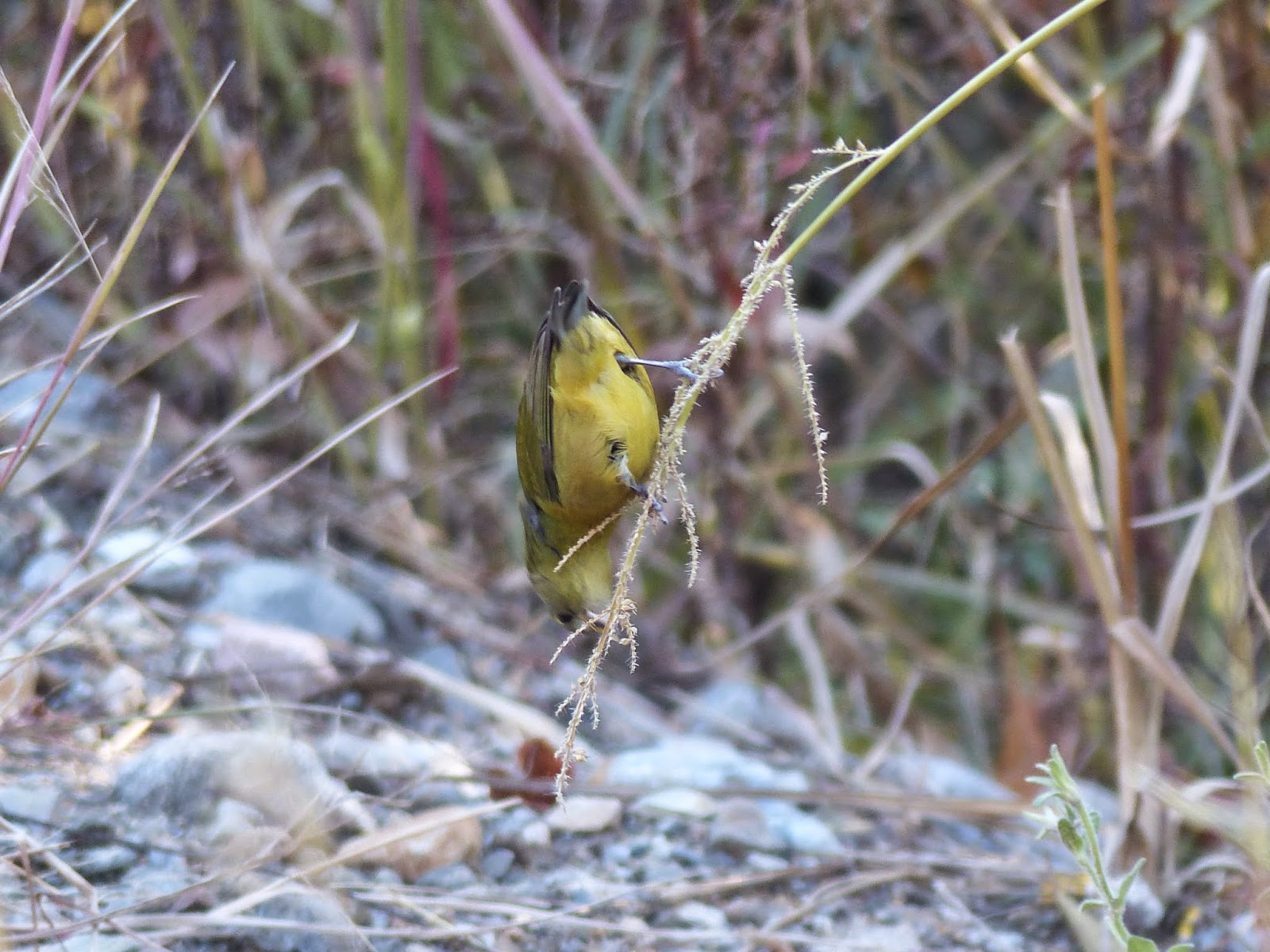 |
| One of the most spetacular monotypic bird families: the Rail-babbler. Photo taken in Malaysia by Jason Lee: https://flic.kr/p/fnUdt7 Used with permission, all rights reserved by photographer |
To give an example, it was discovered that toucans evolved from a particular group of new world barbets. Previously, the toucans had been one family, and the barbets another. But now, instead of being two branches, the toucans were revealed to be only an offshoot of part of the barbet group. There are two ways to make this group monophyletic, and crucially, both of them are perfectly valid, and different authorities could reasonably adopt either. One option would be to subsume the toucans into the barbets, making one big family. The other, which most authorities use, is to keep the toucans, and split the barbets up until no group contains the toucans within it. The result is 5 families: the toucans, the Asian barbets, the African barbets, the New World barbets, and the toucan-barbets. As a side note, all bird family names end in -idae. The toucans are in Ramphastidae, the New World Barbets Capitonidae, and so on.
 |
| Glorified Barbet? Are toucans like this Collared Aracari distinct enough to warrant their own family? It's something of a judgment call. Photo taken by me in Arenal, Costa Rica. |
If it sounds complicated, that's probably why the 4 different checklists of birds of the world that I consulted only agreed on half of the monotypic families. 39 species were placed in their own family by at least one list, but only 20 were on all 4 lists. 6 families were only recognized by 1 list.
The four lists I used were the Clements Checklist (v6.9), the IOC Checklist (v5.1), the Handbook of the Birds of the World (abbreviated HBW), and John Boyd's Taxonomy in Flux List (TiF). The Clements list, currently maintained by the Cornell Lab of Ornithology, is used for eBird and is probably the most well-known list. The IOC list is the product of the International Ornithologist's Union, and the HBW list is produced by Lynx Edicions, a Spanish publisher, and includes full species account for every species. Finally, the TiF list is primarily the work of one man, John Boyd, and is a frequently-updated online taxonomic list that incorporates the most recent studies, with a particular focus on genetic studies. It has fantastic phylogenetic trees of all families, and is definitely worth checking out.
 |
| My working spreadsheet shows the wide disparities in passerine classification between the 4 lists |
Comparing the 4 lists, the TiF checklist is the least bound by tradition, though it tends towards agreement with the IOC list, and prefers splitting up families: it lists 33 monotypic families. The IOC and Clements lists have 33 and 32, respectively, and there's some degree of agreement between the two. The HBW list, on the other hand, is very conservative, preserving many traditional families and lumping groups together, with the result that it only has 22 monotypic families. The agreement between the four is far greater in the non-passerines, where all have between 16 and 18 families, and the disagreement is not whether a family should be recognized, but whether the group in it is a single species or multiple (Osprey and Ostrich are each considered 1 species by some, and 2 by others). On the other hand, there is huge disparity in the passerines: IOC has 17 monotypic passerine families, and HBW only 6. It is definitely possible that a future edition of the HBW list will dramatically restructure the passerines as the other lists have done, and align more closely with them.
 |
| DNA studies have resulted in some radical changes in bird families. This Spotted Elachura, formerly Spotted Wren-babbler, is not at all related to the other wren-babblers. It's the only member of a lineage related to the waxwings. Photo taken in India by Stephen Davis: https://flic.kr/p/eUzoZ7 Used with permission, all rights reserved by photographer |
There are 48 species that are described here: 39 are placed in a monotypic family by at least one of the lists, and the remaining 9 either have historically been considered their own family, or they are a source of disagreement between the lists, and could be placed in their own family in the future. Most of the species are in far-flung parts of the world, so I obviously don't have my own photos for virtually all of them. I'm very grateful to a large number of photographers who have allowed me to use their fantastic photographs. These are either obtained directly from the photographers or via Creative Commons: the permission and license for each photo is listed in the caption. The checklists that recognize each family as monotypic are given in parentheses.
Without further ado, the monotypic bird families of the world!:
Non-Passerines:
 |
| Ostrich photo taken by Sharon Davidson in Kenya: https://flic.kr/p/6xhkHY Used with permission, all rights reserved by photographer |
 |
| Emu photo by Sandy Carroll: https://flic.kr/p/4H6dn7 Used with permission, all rights reserved by photographer |
 |
| Taken in Australia by Wayne Butterworth: https://flic.kr/p/fjsq7z Used under Creative Commons, some rights reserved by photographer |
 |
| Taken by David Ringer in New Caledonia: https://flic.kr/p/4VjrpS Used under Creative Commons, some rights reserved by photographer |
 |
| Taken in Costa Rica by Jeff Dyck: https://flic.kr/p/dWRNGg Used with permission, all rights reserved by photographer |
 |
| Oilbird photo taken by Judd Patterson in Trinidad: https://flic.kr/p/7KonY4 Used with permission, all rights reserved by photographer |
 |
| Taken in Ecuador by David Cook: https://flic.kr/p/5c6TYF Used under Creative Commons, some rights reserved by photographer |
 |
| Photo taken by me! Lake Toho, Florida |
 |
| Hamerkop photo taken by Tarique Sani in Tanzania: https://flic.kr/p/84QLtp Used under Creative Commons, some rights reserved by photographer |
 |
| Shoebill photo taken by Bart Wursten in Uganda: https://flic.kr/p/fhxC6x Used with permission, all rights reserved by photographer |
 |
| Juvenile Magellanic Plover, photo taken in Argentina by Graham Ekins: https://flic.kr/p/ack71S Used with permission, all rights reserved by photographer |
 |
| Taken by Allan Hopkins in the Gambia: https://flic.kr/p/nh7jYM Used under Creative Commons, some rights reserved by photographer |
 |
| Ibisbill photo taken in NE India by Mohanram Kemparaju: https://flic.kr/p/4DGDrV Used with permission, all rights reserved by photographer |
 |
| Plains Wanderer photo taken by Julian Teh in New South Wales: https://flic.kr/p/oLuF7d Used with permission, all rights reserved by photographer |
 |
| A group of Crab-plovers in Tanzania, photo by Riaan Marais. https://flic.kr/p/bCDWTV Used with permission, all rights reserved by photographer |
 |
| Secretarybird photographed in Kenya by Steve Garvie: https://flic.kr/p/k49gkY Used under Creative Commons, some rights reserved by photographer |
 |
| Osprey photo from Florida, taken by Judd Patterson (www.birdsinfocus.com): https://flic.kr/p/ahBi2B: Used with permission, all rights reserved by photographer |
 |
| Taken by David Cook in Madagascar: https://flic.kr/p/dJKZr3 Used under Creative Commons, some rights reserved by photographer |
Passerines:
 |
| Sapayoa photo taken in Panama by Nick Athanas (Antpitta.com) Used with permission, all rights reserved by photographer |
 |
| Sharpbill Photo taken in Brazil by Joao Quental: https://flic.kr/p/nXu3dB Used with permission, all rights reserved by photographer |
 |
| Many-colored Rush Tyrant photo taken by Claudio Dias Timm: https://flic.kr/p/9C5XfK Used under Creative Commons, some rights reserved by photographer |
 |
| Taken in Enga Province, New Guinea by Erik Enbody: https://flic.kr/p/oL1qeR Used with permission, all rights reserved by photographer |
.JPG) |
| Mottled Whistler photo taken by Katerina Tvardikova in New Guinea: PNG Birds Used under Creative Commons, some rights reserved by photographer |
 |
| Bornean Bristlehead photo from Sabah, Borneo, by Alphons Loinsang: https://flic.kr/p/8LZYKR Used with permission, all rights reserved by photographer |
 |
| Ifrita photo taken by Katerina Tvardikova in New Guinea: PNG Birds Used under Creative Commons, some rights reserved by photographer |
 |
| Taken by J. Graham on Tiritiri, New Zealand: https://flic.kr/p/5AGEyp Used under Creative Commons, some rights reserved by photographer |
 |
| Taken in Thailand by Francesco Veronesi: https://flic.kr/p/nHF7RV Used under Creative Commons, some rights reserved by photographer |
 |
| Taken by Kev Chapman in the UK: https://flic.kr/p/9Fhpo6 Used under Creative Commons, some rights reserved by photographer |
 |
| Donacobius photo taken by Claudio Dias Timm: https://flic.kr/p/dTsYvG Used under Creative Commons, some rights reserved by photographer |
 |
| Taken in Uzbekistan by Francesco Veronesi: https://flic.kr/p/eKtAiv Used under Creative Commons, some rights reserved by photographer |
 |
| Taken in Bhutan by Jon Irvine: https://flic.kr/p/nSUKSR Used with permission, all rights reserved by photographer |
 |
| Palmchat photo taken in the Dominican Republic by Carlos de Soto Molinari: https://flic.kr/p/jNA2NA Used under Creative Commons, some rights reserved by photographer |
 |
| Hypocolius photo taken in India by Balaji Venkatesh Sivaramakrishnan: https://flic.kr/p/dH9ppX Used under Creative Commons, some rights reserved by photographer |
 |
| Photo taken by John C. Mittermeier in Sulawesi, Indonesia: https://flic.kr/p/nFkX6z Used with permission, all rights reserved by photographer |
 |
| Wallcreeper photographed in Italy by Francesco Veronesi: https://flic.kr/p/6Co9oD Used under Creative Commons, some rights reserved by photographer |
 |
| Taken in China by Paul Jones: https://flic.kr/p/oeqr81 Used with permission, all rights reserved by photographer |
 |
| Olive Warbler by Ron Knight, Taken in Mexico: https://flic.kr/p/diX1E7 Used under Creative Commons, some rights reserved by photographer |
 |
| Thrush-Tanager photo taken by Rebecca Houseman in Panama: https://flic.kr/p/4wKN76 Used with permission, all rights reserved by photographer |
 |
| Photo by me! Taken in Monteverde, Costa Rica |
-----------
It's quite possible that some of these species will eventually be given their own family, or at least end up somewhere different from where they are now. It is worth noting that this isn't all of the birds whose taxonomic placement is uncertain: only those that are both uncertain and not closely related to others, so that they are potentially candidates for a monotypic family. Feel free to comment if you think anything else should be described here.
Hoopoe(s)-- This striking crested bird from throughout Eurasia and Africa was long considered to be a monotypic family, Upupidae. That family still exists, but it is no longer monotypic: the Hoopoe has been split into 2 or more species. In addition to the familiar Eurasian Hoopoe, TiF and IOC recognize 2 more extant species, the African Hoopoe and Madagascan Hoopoe, as well as the extinct St. Helena Hoopoe. Clements and HBW recognize only 1 additional species, the Madagascar Hoopoe (note the different spelling). The woodhoopoes are in a separate family, Phoeniculidae.
Kinglet Calyptura-- An incredibly rare bird endemic to Atlantic forests in Southeastern Brazil. It is tiny, short-tailed, with a kinglet-like red crown. It had not been seen in over 100 years when it was rediscovered in 1996. There have been no confirmed reports since then, though there have been unconfirmed reports. It is considered critically endangered, because assuming there is still a surviving population it is likely under 50 individuals. There do not seem to be any photos of this bird alive. It's also a taxonomic enigma, being placed with the cotingas, tityras, or tyrant flycatchers. HBW and Clements put it in Cotingidae, while IOC places it with the flycatchers in Tyrannidae. TiF also considers it a flycatcher, but in with the spadebills in a small family split off of the main Tyrannidae, called Platyrinchidae: this placement is based on a recent DNA study.
Silktail-- This striking Fiji endemic looks like a tiny bird-of-paradise but was usually classified as a monarch flycatcher. Small and black, with blue iridescence on the head of the male and a white rump and tail. It is now considered (though HBW still calls it a monarch) to be basal in the fantail family, Rhipiduridae, and its closest relative is the next species, which also was of unclear affinities but placed in a completely different family.
Pygmy Drongo (Pygmy Drongo-Fantail)-- A New Guinea endemic which thought to be an aberrant drongo in Dicruridae (HBW retains this), but which has the wrong number of primary feathers. Small, black, superficially drongo-like, and poorly known, it is now recognized as the sister species of the similarly enigmatic Silktail of Fiji. Together they are basal in the Rhipiduridae, the Fantails.
Yellow-bellied Fairy-Fantail (Yellow-bellied Fantail, Yellow-bellied Flycatcher?)- Unlike the previous two species, this bird moved out of, not into the Rhipiduridae, where HBW places it. It is more closely related to a group of Old Warbler flycatcher-like species, including the species called Fairy Flycatcher, that are collectively now placed in the Fairy Flycatcher family, Stenostiridae. This brightly patterned gray and yellow bird is found in South Asia from Pakistan through the Himalayas and South to Thailand and Vietnam. The common name is the source of some dispute: while Clements, TiF, and IOC agree on the family, they all give different names. Clements calls it the Yellow-bellied Fairy-Fantail, acknowledging both its current and former placement. IOC retains the Yellow-bellied Fantail name, which could be confusing given that it is not a fantail. Even more confusing is the TiF
suggestion of Yellow-bellied Flycatcher, which would conflict with the North American Empidonax flycatcher of the same name. The obvious choice to me would be Yellow-bellied Fairy-Flycatcher, but no list uses that name.
Crested Jay-- The name makes it seem straightforward enough, but this Southeast Asian species found on the Malay Peninsula and the western part of Indonesia is not a typical jay. It is dark brown with a very tall crest and a white blotch on each side of the head. It isn't closely related to the other jays, but Clements, IOC, and HBW still place it with them in Corvidae. The IOC list acknowledges that this is probably outdated, and the TiF list calls it an early (basal) offshoot of the Shrikes and puts it in Laniidae.
Grauer's Warbler-- Not to be confused with Grauer's Swamp Warbler, this drab Central African species is found along the Rift Valley in Burundi, Rwanda, Uganda, and the DRC. Its taxonomic placement is probably somewhere within the mess that used to be the Old World Warblers, but it is relatively distinct and it isn't clear exactly where. Both TiF and Clements put it with the Macrosphenidae, the African Warblers: the former has it as basal in the family, while the latter puts it as incertae sedis at the end. The IOC list gives up entirely and just calls it incertae sedis, while the HBW list puts it in the larger warbler group Sylviidae but acknowledges the confusion.
Cinnamon Ibon-- A rufous canopy-dwelling bird endemic to mountains on Mindanao, in the Philippines. It was once considered an odd member of the white-eye family Zosteropidae, where HBW still places it (though notes that this may be incorrect). Surprisingly, mtDNA studies have found that it is the early offshoot of the Old World Sparrows, a group that includes the familiar House Sparrow. As a result TiF, Clements, and IOC put in that family, Passeridae.
São Tomé Short-tail (Bocage's Longbill)-- Another enigmatic island species whose relationships are now thought to be resolved. It used to be (and on the HBW list still is) in Sylviidae. The other lists now consider it to be closer to the pipits, and place it in Motacillidae. It is rare and only found on São Tomé, off the coast of West Africa. It is a rather drab brown and gray forest floor bird.
Wrenthrush (Zeledonia)-- An elusive and unique bird found only in the mountains of Costa Rica and Panama. Short-tailed and round, this gray bird has a striking orange crown. It forages on the ground, but despite its name is neither a wren nor a thrush. It is probably either its own family or a wood-warbler (Parulidae): Clements and HBW go with the latter, while IOC and TiF play it safe and characterize it as incertae sedis for the time being. Of these twelve, this is probably the most likely to end up as a monotypic family.
Yellow-breasted Chat-- I first learned to identify this species, the oddball bird of the Eastern US, as a weird wood-warbler. It certainly doesn't resemble the other warblers very much, and alternatives have been suggested but not proven. HBW and Clements call it a warbler, TiF puts it in Icteridae as a New World Blackbird, and IOC calls it incertae sedis.
Plushcap-- A distinctive South American bird found from Venezuela to Bolivia. Rusty and gray with a vivid yellow cap (made up of dense velvety feathers: hence the name), it resembles little else and was until recently given its own family, Catamblyrhynchidae. It is now generally agreed to be a tanager, and placed by all four lists in Thraupidae.
-----------------






